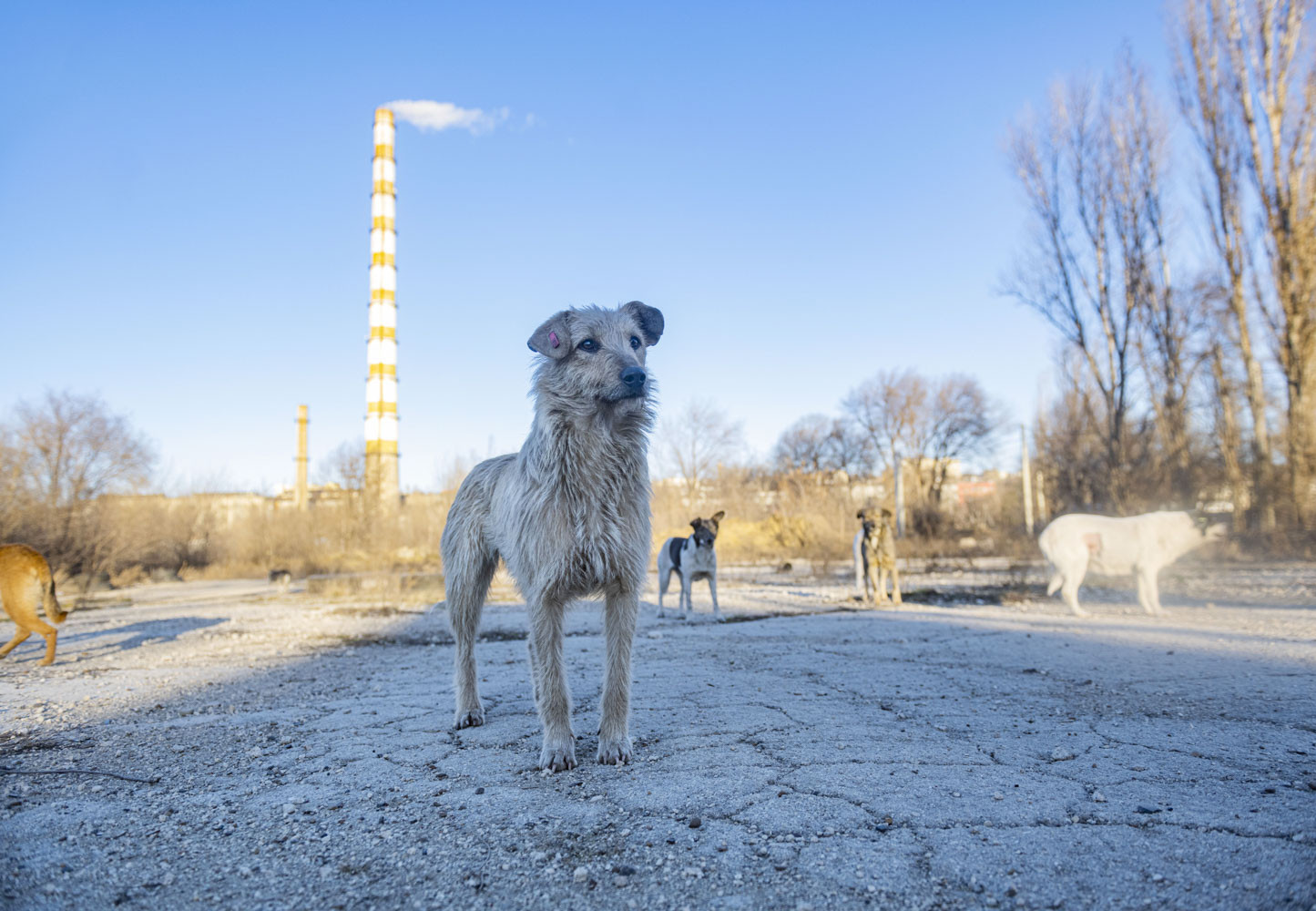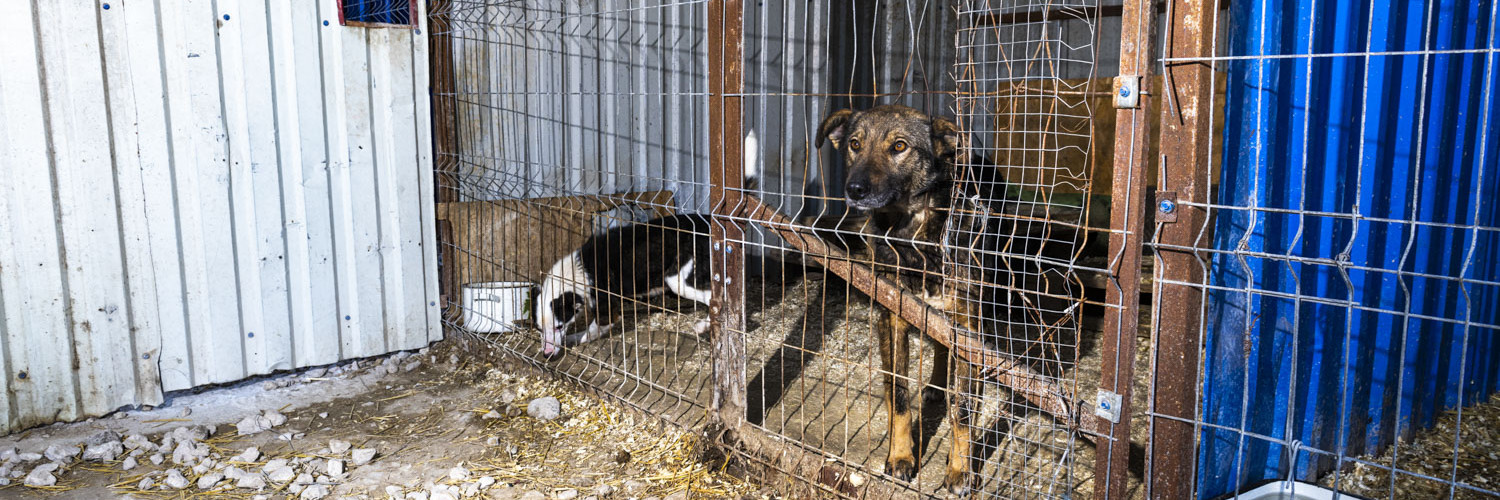
Hope for Moldova's Stray Dogs
A blog post by photographer and animal advocate Sophie Gamand
In the Republic of Moldova, a small ex-Soviet Union country landlocked between Ukraine and Romania and the poorest country in Europe, free-ranging dogs are omnipresent. FOUR PAWS has launched an emergency relief support program in the country, in partnership with Doctor Vet Moldova, a local animal welfare organization. Together, we are implementing a long-term, sustainable, and strategic Dog Population management program, using FOUR PAWS’ high-volume CNVR approach (Catch – Neuter – Vaccinate – Return).
“Watch your step!” someone yelled above the screeching sound of barking dogs. A small pup in a diaper zipped toward me, dragging his paralyzed legs. I painstakingly navigated a room full of yapping dogs waltzing around my feet, competing for attention. I had just entered Doctor Vet Moldova’s veterinary clinic in Chișinău, where FOUR PAWS had set up their high-volume spay/neuter clinic for stray dogs. In the surgery room, the team was already hard at work, operating on a medium-sized dog.
After the surgery and a couple of days in observation, the dogs would be returned to the street. In CNVR, the R doesn’t stand for "Release”, but for “Return” because the dogs are not just let loose on the streets, they are returned to the exact same spot they were taken from.
A bustling shelter and a dog named Boss
Doctor Vet Moldova’s main shelter was further away, in the Cricova region known for its delicious wines. Funded mostly by the meager proceeds of their Chișinău low-cost veterinary clinic, the facility housed 160 dogs and cats. Come Winter’s end, tens more would join, though every enclosure seemed already full.
I walked around the kennels, pursued by the deafening sound of barking dogs desperately calling for attention. I have always found shelters to be overwhelming. Not only because of the assault on senses, but because of the emotional weight attached to seeing all these dogs in limbo, waiting on life.
Over three years ago, Vlad (he founded Doctor Vet Moldova in 2017) received a call about a “very aggressive dog.” Boss was found with a chain around his neck, his body covered in wounds. He looked like he had been tortured and had just escaped his tormentors. Vlad’s team brought him to the shelter, where at first, Boss struggled. Soon, he had warmed up to the staff and is now a favorite.
Shortly after Boss arrived at the shelter, Vlad got another call about Ella, a large female dog who also came from an abusive background. When they introduced her to Boss, it was “love at first sight”, the team explained. For three years, Boss and Ella lived together in their kennel, “like a family.”
Sadly, Ella got sick and passed away. Ever since, the team is convinced that Boss is in mourning. They tried to find him another companion, but nobody has worked out yet. Boss received adoption applications, but no match was made so far.

Upon hearing Boss’ story, my heart broke. I felt sadness and awe for the beauty and grace I had just witnessed: the profound love Boss’ caretakers had found for him, and the stories they told themselves to continue their impossible work. Was Boss really mourning? Or were his caretakers in need of a place to hold their own pain?
Coming into this trip, I had a sense of renewed hope. I was excited to learn more about FOUR PAWS’ CNVR approach for street dogs. I knew of similar programs like Trap-neuter-return (TNR) for stray cats but had never heard of such programs for dogs. Could we spay/neuter stray dogs and return them to the street, instead of sheltering them?
Some people would think it cruel, to return a dog to the streets where his life is at risk every day. But that same mentality – the idea that we should and can save all the dogs – has birthed a broken, costly system. We have filled shelters to the brim. Millions of dogs languish in cages, sometimes for years, and too many are euthanized for “lack of space” each year.
All around the world, rescue organizations face the same challenges. No matter how many sacrifices, no matter how much the exhausted rescue community does, it is just never enough. Our approach has led to the warehousing of sentient beings, and the desperation of the people who care for them.

Mass spay/neuter campaigns are the only way out of this. But funding for such initiatives is hard to come by. Cities usually struggle to dedicate the resources needed, and private donors would rather support flashy, gratifying, tear-jerking rescue stories performed by eye-candy social media influencers... spaying and neutering isn’t exactly as glamorous.
While officials struggle to implement long-term, humane solutions, what to do with the countless dogs who currently call the streets their homes? If we think these dogs do not belong in kennels, and if no homes are available for them, as is the case in Moldova, where do these dogs belong?
Should these dogs – and could they – live in the street, in collaboration with their community?
The emotional equation of CNVR
Vlad and his team member Stepan handled the first phase of CNVR: the catching of dogs. Vlad used a long blowpipe, and tranquilizer darts. The goal is to make the procedure the least intrusive and traumatizing as possible, for the dogs but the community as well. “People would be very concerned if they saw us walk around and shoot at dogs with guns. This way, they understand what we are doing.”
A dog was identified in consultation with the community (some of the free-roaming dogs have families), then lured to a spot with some dog food. While the dog gobbled the food, Vlad drove closer, adjusted his aim, and expertly blew the dart straight into the dog’s rear end. The blow was quiet and swift.
The dog let out a small, outraged yelp, looked at us in disbelief, and took off. Zipping through buildings fast, crossing through gardens, he headed towards the adjacent street. Radios in hand, Vlad and Stepan hurried, not to lose sight of the dog. We found the dog, tongue hanging, passed out from the powerful drugs, on a sidewalk. Vlad cautiously checked whether the dog was fully asleep, then grabbed him by the neck unceremoniously, and placed him into a crate.
Part of the CNVR approach includes the surveying of free-roaming dogs. This step is essential to best prepare for and measure the impact of CNVR, as well as to understand what kind of dogs live on the street and what their needs might be: are they owned pets, pets who were abandoned, strays born in the street? What kind of health issues are they facing? Where do they live? How many are they?
Twice a day (early morning and late afternoon), a FOUR PAWS team drove a predetermined route. During surveying, the team does not interact with the dogs – no stopping, no feeding, no touching. Studying at a distance, they dutifully note the locations and numbers of dogs.
Before heading to Moldova, the emotional challenges linked to CNVR were not lost on me but given the scale and urgency of the problem, I thought it made sense to deal with it statistically, almost cold-heartedly, processing dogs one after the other.
Yet, once on the ground with Vlad, driving around and meeting groups of street dogs, my rationale fell apart. While I understood why the local community, overrun with strays, saw them as a problematic, anonymous whole – and to be fair, large groups of stray dogs can be dangerous – I just couldn’t help but connect to the individuals.
Observing these groups, I imagined social dynamics beyond survival: love, friendship, hate... Complex bonds. For a split second I felt sadness over the sterilization of these dogs. Part of me thought: if we sterilize the dogs, there will be less dogs, which means the remaining street dogs, as their population dwindles, will end up very lonely? It was a fleeting thought, silly even, not rational – or scientific. I brushed it away quickly. “We want less dogs roaming” I reminded myself. They deserve better.
Towards the end of the day in Moldova, I was confronted to perhaps the biggest emotional downside of CNVR. As the sun reached the golden hour near a factory, two minuscule puppies waddled towards me, their shy tail wagging furiously. One of them hid underneath me, between my feet. He was adorable, precious, vulnerable, and it was excruciating not to pick him up. We walked back to the car and both teeny puppies chased us playfully. They were so innocent and beautiful. Vlad looked at me, shrugging his shoulders in a powerless motion. We slammed the car’s door and drove away. In the mirror, I caught the puppies looking back at us.
I tried not to think about them too much. There was no room for them at the shelter. But leaving such tiny puppies out there felt awful. Rescuers leave dogs behind all the time. It is part of the harsh reality of the job. But this is when the CNVR conundrum hit me the hardest. For CNVR to make sense, Doctor Vet and FOUR PAWS must stick to the plan and dedicate their limited resources to their goal, the bigger picture: the spaying/neutering of as many dogs as possible. Taking dogs in, puppy after puppy, can only devour resources and clog the system.
As heartbreaking as it is, Vlad cannot take all the dogs in. He simply cannot afford to. He must stay the course.
FOUR PAWS' work in Moldova
In 2020, a FOUR PAWS SAC team visited Moldova for an emergency relief project and to set up initial contacts, followed by a special veterinary support project in 2021. With so many dogs in the country everywhere, there is only one way forward: to set up, together with the community, a systematic, sustainable, and humane dog population management program to avoid further dogs being born onto the streets in the next years and to, overtime, reduce the number of strays. This is why FOUR PAWS is back in the country since January 2023 and supporting first steps towards such a program through a collaboration with the local partner Doctor Vet Moldova.
Note: Any advertisements that may appear during the viewing of this video are unrelated to FOUR PAWS. We assume no liability for this content.

Sophie Gamand
Sophie Gamand is a French award-winning photographer, artist and animal advocate. She is passionate about rescue dogs and her images create a ripple effect. By engaging her community, and leveraging her social media presence, Sophie has helped various animal non-profits around the world. On top, she has won several prestigious photography awards for her work (including a Sony World Photography Award in 2014), as well as advocacy awards for her dedication to animal rescue and adoption. Sophie's work has been featured, among others, in National Geographic, Oprah Magazine, The Huffington Post, The Guardian, The Independent, La Repubblica and CNN.
You can find more about Sophie's work here:

















